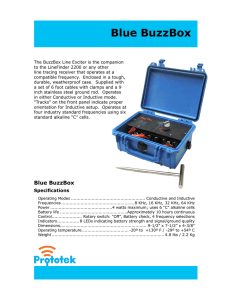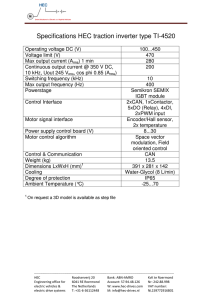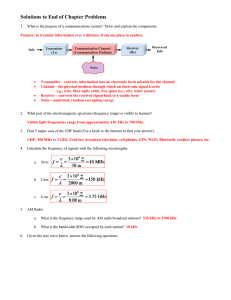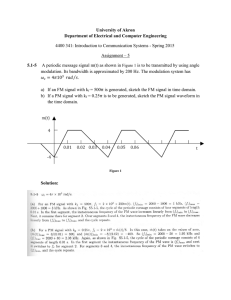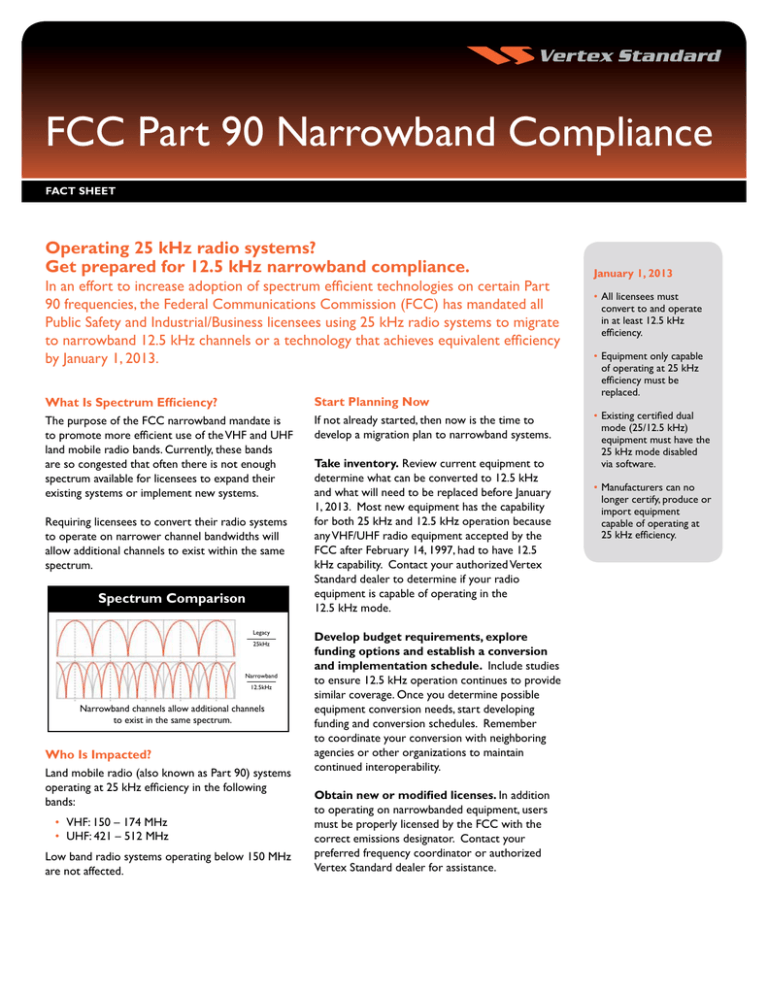
FCC Part 90 Narrowband Compliance
FACT SHEET
Operating 25 kHz radio systems?
Get prepared for 12.5 kHz narrowband compliance.
In an effort to increase adoption of spectrum efficient technologies on certain Part
90 frequencies, the Federal Communications Commission (FCC) has mandated all
Public Safety and Industrial/Business licensees using 25 kHz radio systems to migrate
to narrowband 12.5 kHz channels or a technology that achieves equivalent efficiency
by January 1, 2013.
What Is Spectrum Efficiency?
Start Planning Now
The purpose of the FCC narrowband mandate is
to promote more efficient use of the VHF and UHF
land mobile radio bands. Currently, these bands
are so congested that often there is not enough
spectrum available for licensees to expand their
existing systems or implement new systems.
If not already started, then now is the time to
develop a migration plan to narrowband systems.
Requiring licensees to convert their radio systems
to operate on narrower channel bandwidths will
allow additional channels to exist within the same
spectrum.
Spectrum Comparison
Legacy
25kHz
Narrowband
12.5kHz
Narrowband channels allow additional channels
to exist in the same spectrum.
Who Is Impacted?
Land mobile radio (also known as Part 90) systems
operating at 25 kHz efficiency in the following
bands:
• VHF: 150 – 174 MHz
• UHF: 421 – 512 MHz
Low band radio systems operating below 150 MHz
are not affected.
Take inventory. Review current equipment to
determine what can be converted to 12.5 kHz
and what will need to be replaced before January
1, 2013. Most new equipment has the capability
for both 25 kHz and 12.5 kHz operation because
any VHF/UHF radio equipment accepted by the
FCC after February 14, 1997, had to have 12.5
kHz capability. Contact your authorized Vertex
Standard dealer to determine if your radio
equipment is capable of operating in the
12.5 kHz mode.
Develop budget requirements, explore
funding options and establish a conversion
and implementation schedule. Include studies
to ensure 12.5 kHz operation continues to provide
similar coverage. Once you determine possible
equipment conversion needs, start developing
funding and conversion schedules. Remember
to coordinate your conversion with neighboring
agencies or other organizations to maintain
continued interoperability.
Obtain new or modified licenses. In addition
to operating on narrowbanded equipment, users
must be properly licensed by the FCC with the
correct emissions designator. Contact your
preferred frequency coordinator or authorized
Vertex Standard dealer for assistance.
January 1, 2013
•All licensees must
convert to and operate
in at least 12.5 kHz
efficiency.
•Equipment only capable
of operating at 25 kHz
efficiency must be
replaced.
•Existing certified dual
mode (25/12.5 kHz)
equipment must have the
25 kHz mode disabled
via software.
•Manufacturers can no
longer certify, produce or
import equipment
capable of operating at
25 kHz efficiency.
FCC Part 90 Narrowband Compliance
vertexstandard.com/lmr
FACT Sheet
Vertex Standard
12.5 kHz Radios
Portables
VX-231
VX-350 Series
VX-410 Series
VX-420 Series
VX-450 Series
VX-820 Series
VX-920 Series
VXD-720
Mobiles
VX-2100
VX-2200
VX-4500
VX-4600
VX-5500
VX-6000
VX-7200
VXD-7200
Repeaters
VXR-1000 (UHF)
VXR-7000
VXR-9000
VXD-R70
Frequently Asked Questions
Will I need to change the frequency band used to be compliant?
No. Narrowbanding does not require moving to another frequency band. Licensees stay on the same channel
center(s), but reduce the bandwidth of the channel(s) currently used, from 25 kHz to 12.5 kHz.
If I need to upgrade equipment, do I need to implement digital equipment?
No. The 12.5 kHz narrowband equipment is available in both conventional analog and digital formats
(e.g. Project 25). After January 1, 2013, analog and digital equipment must operate on a 12.5 kHz channel
or achieve equivalent efficiency.
What does it mean to use technology that achieves equivalent efficiency?
For voice applications, the FCC efficiency standard can be met if equipment either operates on a 12.5 kHz channel
or transmits at least one voice channel per 12.5 kHz of bandwidth. This means equipment operating on a 25 kHz
channel bandwidth is compliant if the equipment supports two ore more voice channels.
Has the FCC established a schedule for mandatory migration to 6.25 kHz bandwidth?
No. The FCC has not set any date by which licensees must operate in 6.25 kHz efficiency.
How can I determine if I have a valid FCC license?
Contact a certified frequency coordinator or authorized Vertex Standard dealer for assistance.
Refer to the FCC website for listing of frequency coordinators:
http://wireless.fcc.gov/services/index.htm?job=licensing_3&id=industrial_business
If I currently have a license for a 25 kHz channel, will I automatically be entitled to license two
12.5 kHz channels?
No.Your 12.5 kHz channel will remain on the same channel center.Your current 25 kHz channel will not be split
into two 12.5 kHz channels.You will need to justify and apply for the additional 12.5 kHz channels to the FCC
through a certified frequency coordinator.
What will happen if I fail to comply with the FCC narrowbanding mandate? Can I continue to
operate at 25 kHz efficiency on a secondary status after January 1, 2013?
No. The FCC will prohibit licensees from operating non-compliant equipment on a secondary basis.
Non-compliance will be considered a violation subject to FCC Enforcement Bureau action, which may include
admonishment, monetary fines and loss of license.
Will migration to 12.5 kHz change my system coverage area?
Maybe. Conduct tests during conversion to ensure your system continues to provide similar coverage. Contact
your authorized Vertex Standard dealer to help you determine if transmitter site changes or additions will be
required to compensate for possible coverage change.
Additional Resources
Visit the Vertex Standard FCC Narrowband Center at www.vertexstandard.com/lmr
FCC Rules:
•Code of Federal Regulations (CFR), sections 90.209(b)(6)(i), 90.209(b)(6)(ii) and 90.209(b)(5) for licensee deadlines, and
90.203(j)(3) and 90.203(j)(10) for manufacturer deadlines: http://www.access.gpo.gov/nara/cfr/waisidx_08/47cfr90_08.html
• FCC narrowbanding guidelines summary:
http://www.fcc.gov/pshs/docs/public-safety-spectrum/General_Information_on_VHF-UHF_Narrowbanding.pdf
FCC Licensing and Coordination Guidelines:
• FCC Wireless Telecommunications Bureau, Public Safety and Homeland Security Bureau sites for licensing and frequency
coordination procedures: http://wireless.fcc.gov/services/index.htm?job=service_home&id=industrial_business and
http://www.fcc.gov/pshs/public-safety-spectrum/coord.html
Specifications are subject to change without notice or obligation. Vertex Standard is a trademark of Vertex Standard LMR, Inc. All other trademarks are the property of their respective owners.
© 2012 Vertex Standard LMR, Inc. All rights reserved. 01/2012

